

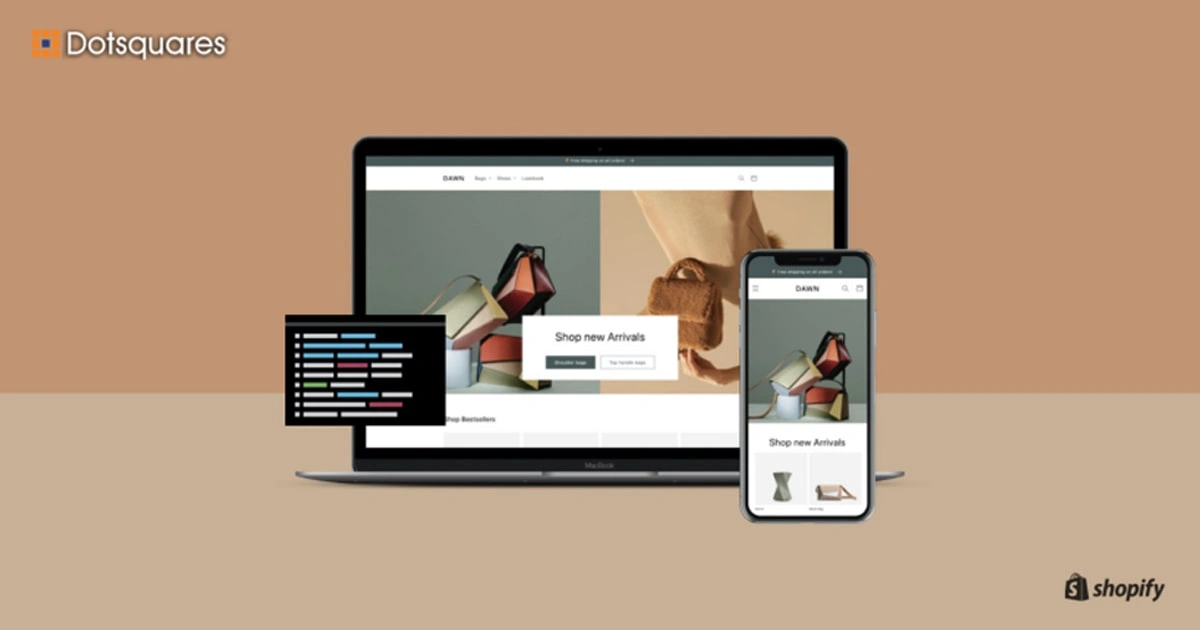
Imagine you could focus more of your efforts on product design and innovation, improving your brand, or streamlining operations - instead of finding customers and worrying about sales.
For some entrepreneurs, these things come more naturally than marketing, which can make sustaining and growing a business a struggle. Luckily, there's a way you can pass on some (or even all) of that responsibility to other businesses by creating a wholesale channel.
Whosale is selling your products in bulk to another retailer, usually at a discounted price, who then sells the product to their customers.
It's important to note that creating a wholesale channel for your business still allows you to sell your product to the end consumer.
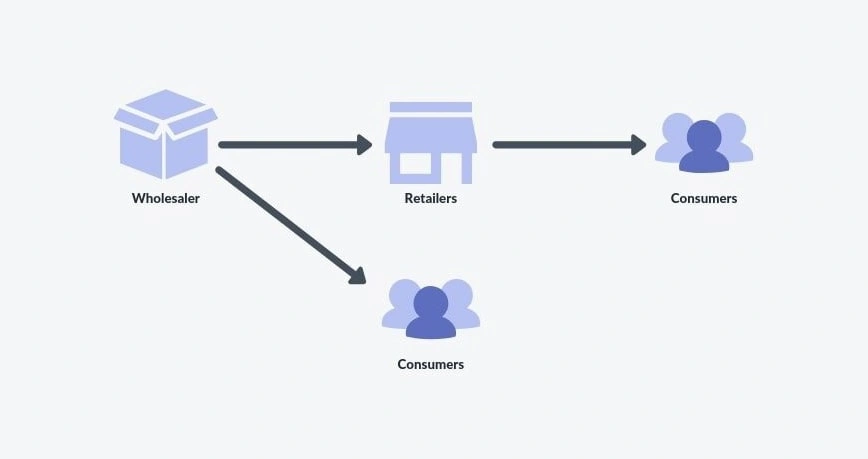
As a wholesaler, you can sell to both consumers and other retailers. You don't have to choose one or the other.
The first examples of wholesale businesses that might come to mind are probably large brick-and-mortar department stores, like Walmart or Zellers. Wholesale is, after all, often thought of as an old fashioned business model that’s being disrupted by newer direct-to-consumer eCommerce businesses.
However, in more recent years, wholesale has experienced a revolution of its own due to online marketplaces like Amazon, Wish and Wayfair. While eCommerce enables direct-to-consumer brands to thrive by lowering the barrier to set up shops, wholesale still offers consumers a convenient shopping experience, showcasing everything they need in one place.
This newer version of wholesaling, which often takes place in online marketplaces or through smaller boutiques, has advantages that attract direct-to-consumer brands too. Here are 3 reasons why opening up a wholesale channel might benefit your business:
As a direct-to-consumer brand, a large amount of your budget needs to be allocated to marketing. For every new customer acquired, there is often a cost, after all.
By selling your products wholesale, you can let another business shoulder the cost of acquiring customers, and reinvest your time and money in other areas of your business.
Acquiring new customers costs money, and building a loyal audience of fans and customers is not an easy task. By creating a wholesale partnership with an established brand that has already made a name for itself within your niche, you can leverage the company's goodwill to get your product into the hands of consumers.
Expanding your business to a new country or territory comes with a series of associated costs like warehousing and logistics, or a new marketing approach to a population that hasn’t heard of you. Finding another retailer with an existing presence and supply chain in a new market can help reduce the risk of international expansion by cutting your setup costs.
Ultimately, a wholesale business model benefits both the retailer and the wholesaler by creating efficiencies. The retailer gets a new, often complementary, product to sell without investing in research and development, and the wholesaler saves money on marketing by gaining direct access to an existing customer base.
Pricing is one of the crucial components of creating a successful wholesale business. When selling direct to customers on your website or in your retail store, you get to keep whatever profit you set for yourself.
With wholesale, businesses typically give retailers a 50% discount off their regular retail price. The steep discount is to allow retailers to wholesale your product to their customers, while still retaining some profit margin as well. Here is an example of a healthy pricing strategy, where a wholesale business would be retaining a 50% profit margin on wholesale orders and a 75% profit margin on direct-to-consumer sales.
| Product SKU | Product Cost | Wholesale Price | MSRP |
|---|---|---|---|
| SLK101B | $20.00 | $40.00 | $80.00 |
| SPL103B | $12.00 | $24.00 | $48.00 |
| SPL107B | $6.00 | $12.00 | $24.00 |
Therefore, to create a successful wholesale business, you will need to be able to offer a large discount on your retail price to those willing to wholesale your product. This can sometimes pose various risks for small businesses, including not being profitable.
Luckily, there are ways you can price your product for wholesale to mitigate the risk of not being profitable. One way is to offer a discount based on order quantity. This way, retailers will be encouraged to place larger orders to get a better margin upon resale of your product. Many wholesale businesses set minimum order quantities (MOQs) that retailers must buy to carry their products.
When you decide to wholesale your product and have it carried by multiple different stores, you can sometimes run into issues with competing retailers undercutting each other when it comes to price. This is why creating an MSRP (Manufacturer's Suggested Retail Price) is an important element of your wholesale pricing strategy.
An MSRP is often a part of a contract that any business will give to a retailer that wants to sell their products. It guarantees that the retailer will stick to the suggested retail price so that the product pricing will be the same whether it is found in stores or online. Usually, the MSRP is found alongside individual products on a wholesale storefront, or on a sales sheet /product brochure sent to prospective retailers who wish to carry your product.
One thing to consider when setting up an MSRP agreement is whether or not you want to allow discounting around holidays like Black Friday and Cyber Monday or specify certain times you might want to discount the product on your website to customers.
As the wholesale supplier you get to set the rules that your retailers have to comply with, but maintaining a fair balance with pricing is essential to making your retailers successful. If your retailers can make a profit selling your product, they will continue to come back and place larger orders.
When it comes to creating your wholesale business online, you first need to consider whether you want to create a pure wholesale business or offer a wholesale option in addition to selling directly to consumers through your store.
There are multiple ways you can approach this and what you choose will ultimately depend on your context.
If you are considering only selling your product wholesale through other retailers, you will need to create a password protected online store so that only your retailers can place orders at your discounted price.
The easiest way to lock your online store is through Shopify’s password protection feature, available in the Shopify
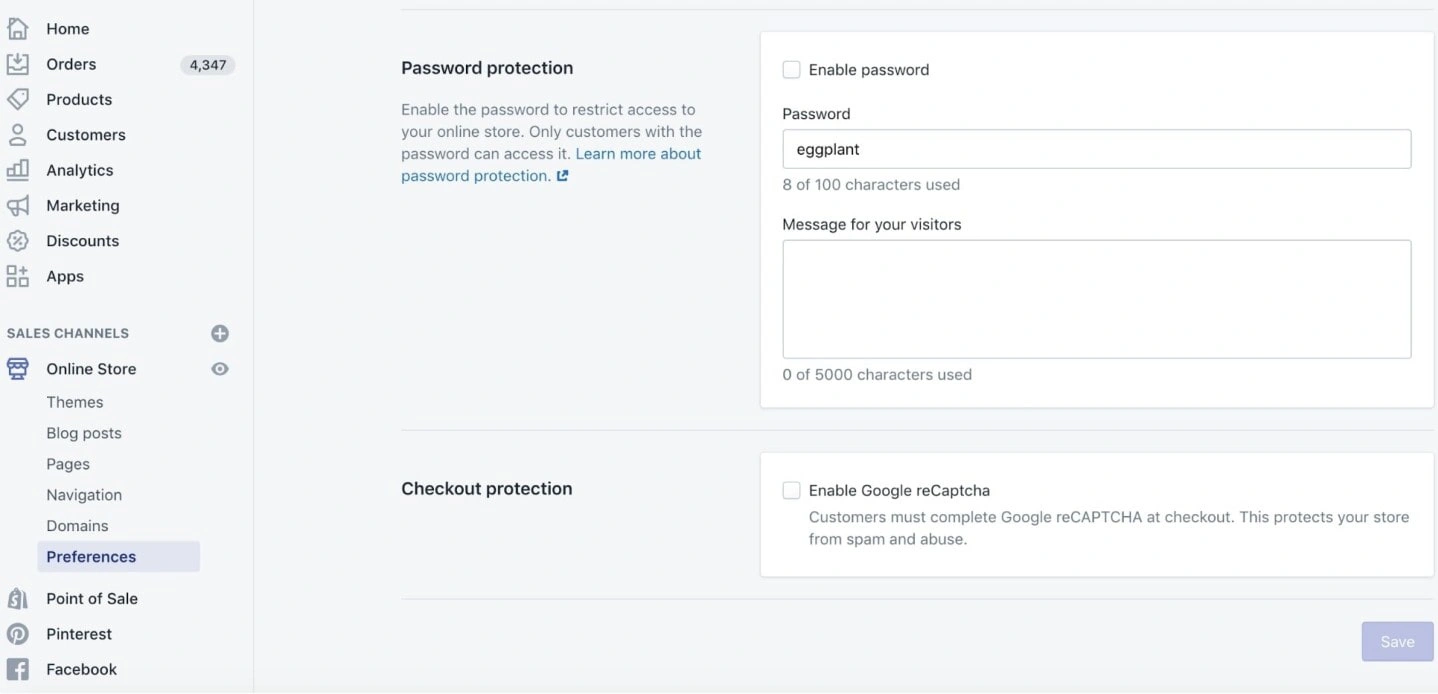
Your Shopify store can be password protected under Online Store > Preferences.
By creating a password protected online store, you can set up all your products with a discounted price for your retailers to purchase.
If you are running a larger wholesale business and are worried about your password getting out to unapproved retailers, you might want to look into a more sophisticated password protection app like Locksmith.
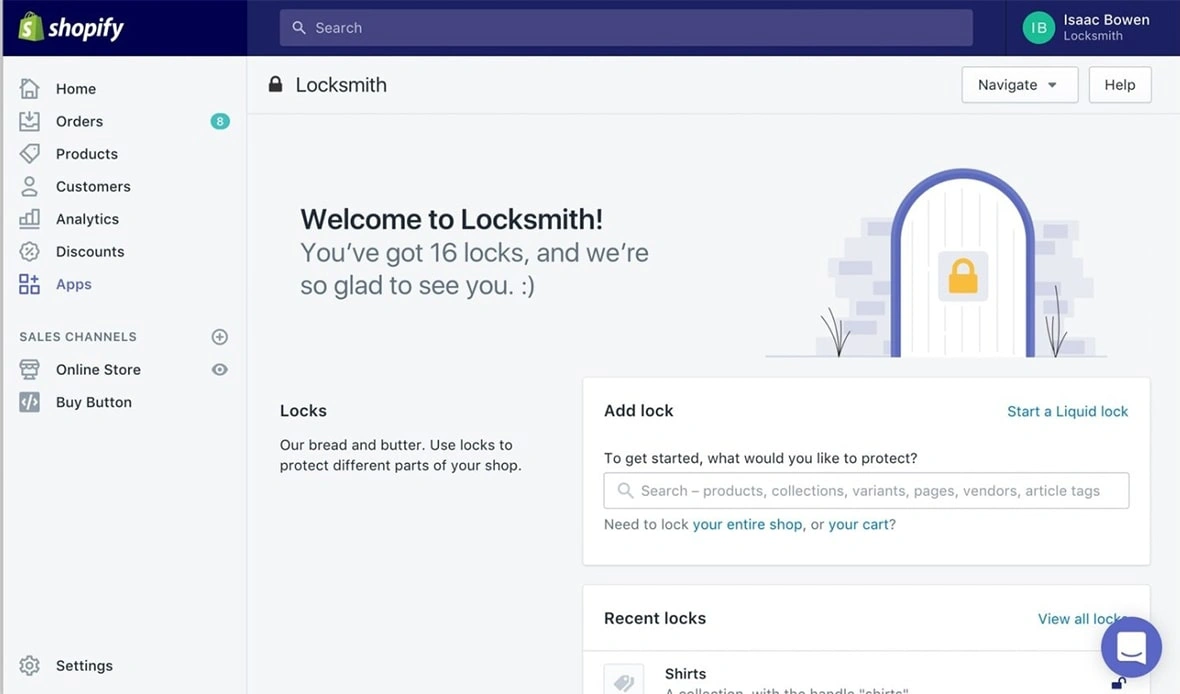
Locksmith has many customization features, which give you advanced control over who can see your store and what products they can purchase. Instead of creating one generic password, customers can create accounts and set up their unique passwords.
You can also grant customers access to products by applying tags to their profile, sharing a secret link with them, personalizing your inventory based on what country they're browsing from, along with many other conditions.
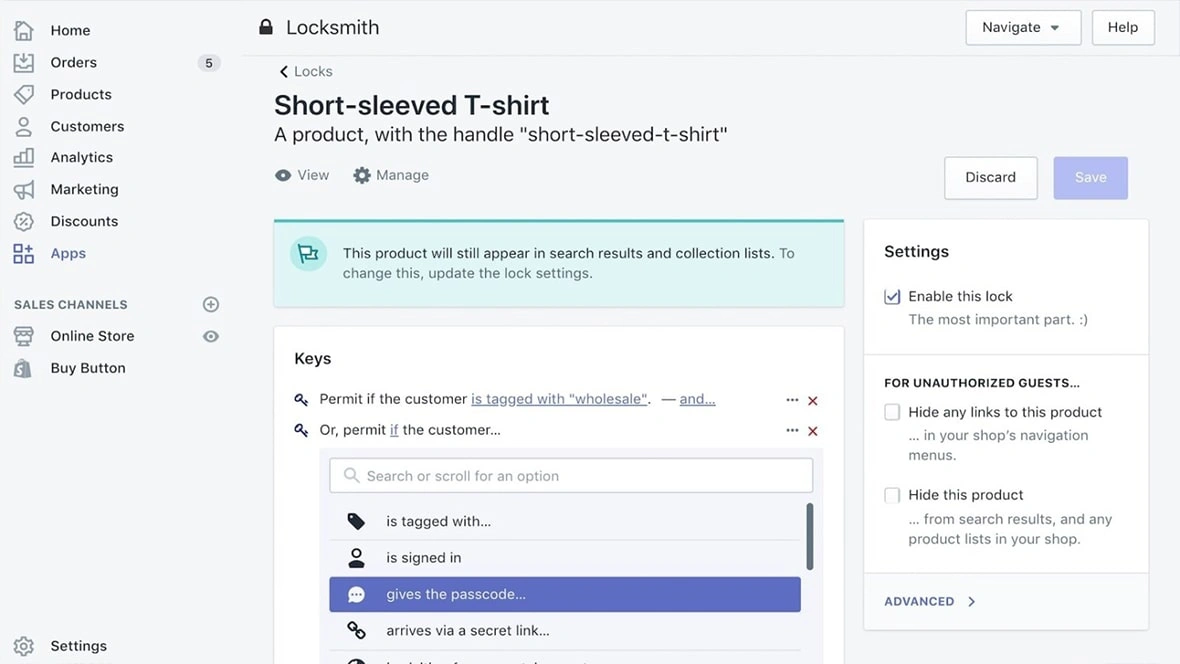
With Locksmith you can choose who has the access to specific parts of your store, and how you share that access with them.
For businesses that already have a direct-to-consumer store, but want to create a wholesale channel for retail businesses, there are several options available. The simplest one would be setting up a second Shopify store with a different URL, and using one of the two options listed above to password protect it.
If your company is doing a high volume of sales, you can consider upgrading to Shopify Plus and taking advantage of its wholesale channel feature. On Shopify Plus, you can create a wholesale channel within your existing store that is password protected.
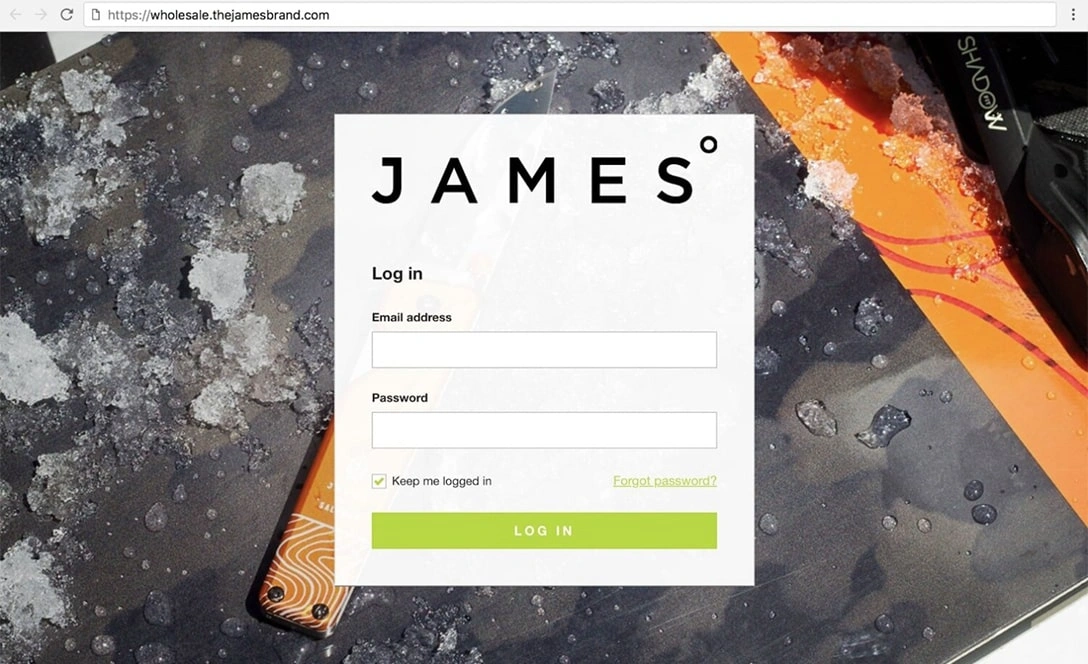
The wholesale channel creates a wholesale storefront using your existing products, so there is very little additional work involved in setting up this channel. You can also customize pricing by customer groups, using percentage discount or volume-based discount. The best thing about it is that your sales reports are all separated from your direct-to-consumer sales within Shopify reports.
Another way to create a wholesale channel on your Shopify store is with the assistance of a Shopify app Wholesale Club. With Wholesale Club, businesses can break up their retail customers into “tiers” which are assigned specific discounts.
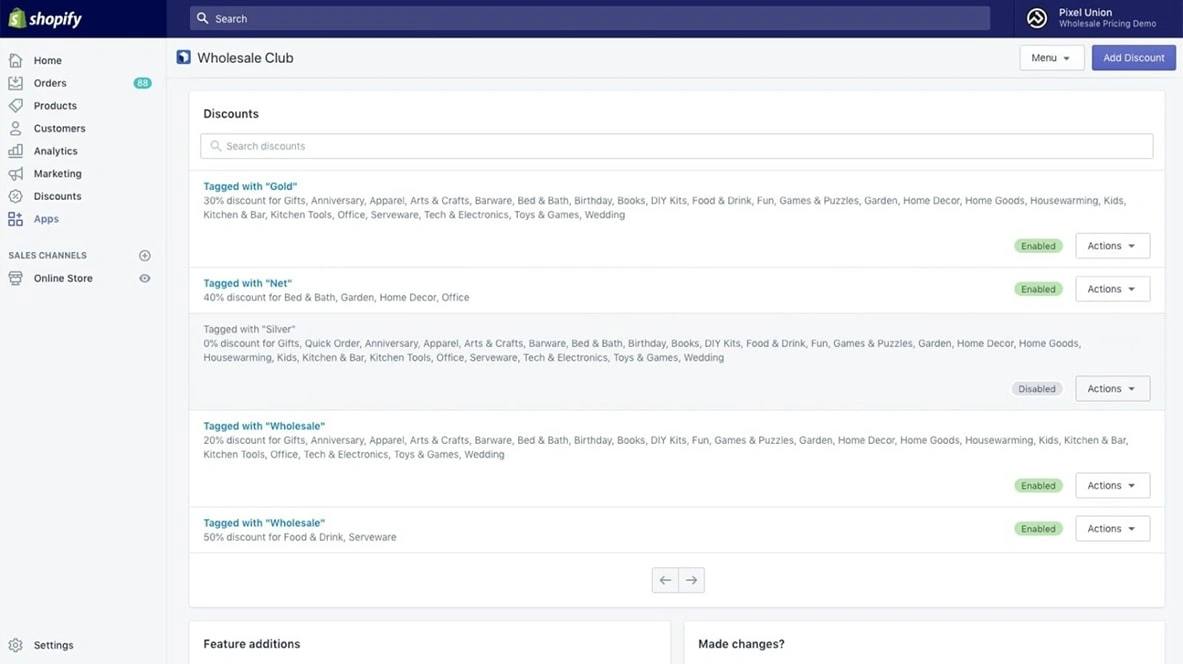
Discount tiers on the Wholesale Club app can be assigned using customer tags.
The app has a built-in marketing feature that can be used to incentivize customers to buy more in order to get a larger discount.
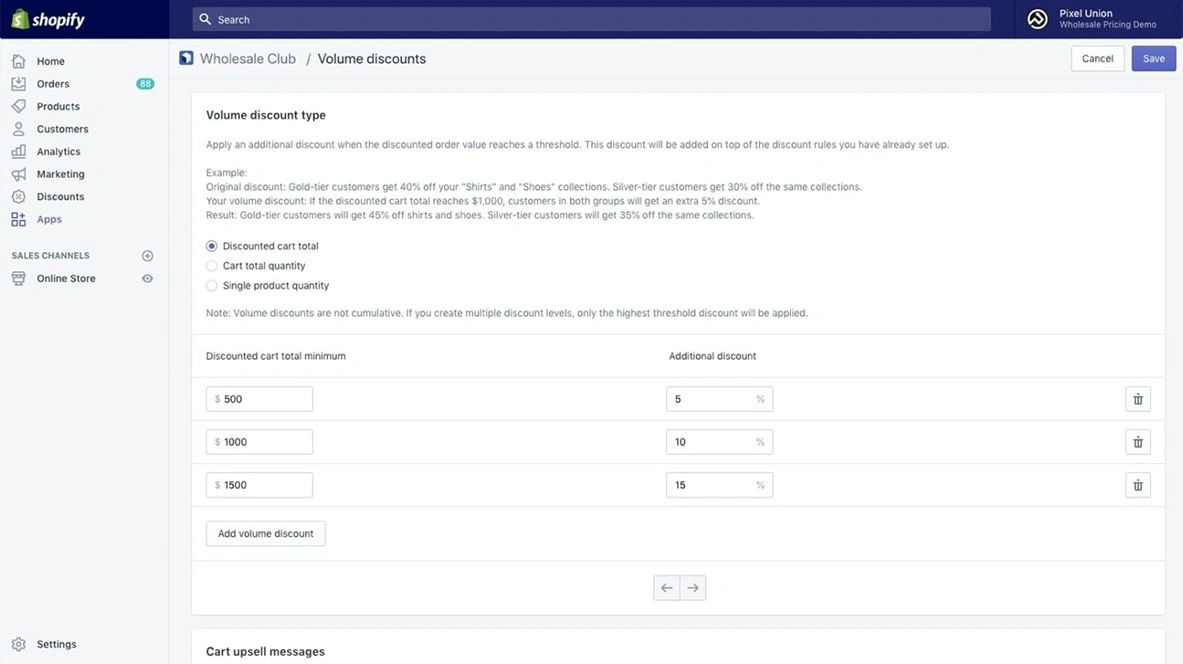
Volume-based discounts can be given to wholesale customers based on cart total and item quantity.
With Wholesale Club, only customers who have approved retailer accounts and are logged in will get access to wholesale pricing. This allows you to create a secure wholesale channel in addition to your direct-to-consumer one, without the need to set up a separate store or product catalogue.
One thing that differs wholesale from direct-to-consumer transactions is often the payment terms. Unlike a regular sale, if a retailer is buying a large quantity of your product, they may ask for payment terms that are often referred to as "Net X": an agreement that the net payment is expected in full within a set number of days (e.g. Net 30 for payment within 30 days).
If a retailer is asking for these preferred payment terms, it means that they want to be able to pay you, as a vendor, within a certain number of days after receiving their order. Shipping a large order to a retailer before they’ve paid you can be risky, especially for small businesses. This is why it is often suggested that you ask for references and perform some due diligence before agreeing to these terms.
Both of the Shopify apps Wholesaler and Wholesale Club allow you to offer customers net payment terms. Customers can be tagged according to the payment terms agreed upon with them, and when they shop in your store they can place unpaid orders.
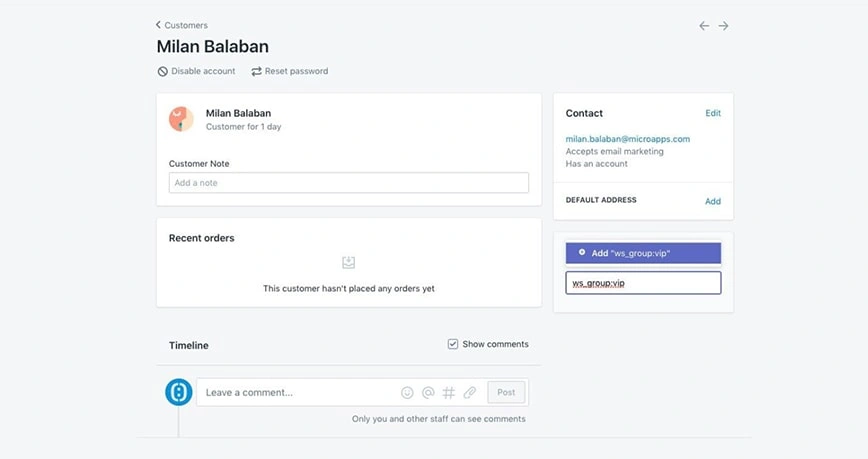
With Wholesaler, tagging customer profiles will give them net payment privileges.
When it comes to collecting a later payment, there are a few options for businesses managing their wholesale channel online. One is to record wholesale orders as draft orders on your Shopify store, which allows you to email invoices to your customers through Shopify for them to pay at a later date. With draft orders, you can also record a payment via cheque by marking an order as paid once the payment is received.
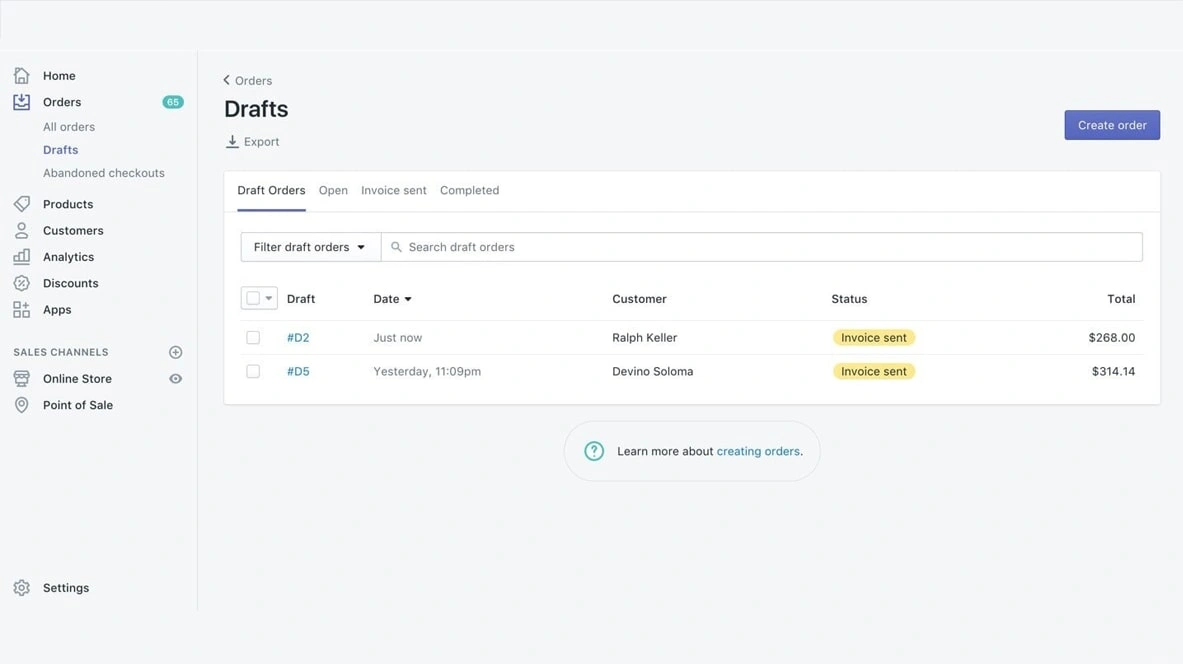
Under Drafts, store owners can create orders and send customers invoices to be paid at a later date
Afterpay is another potential solution to taking late payments. The app is usually used for direct-to-consumer sales, allowing stores to offer customers the ability to pay for their purchases in installments.
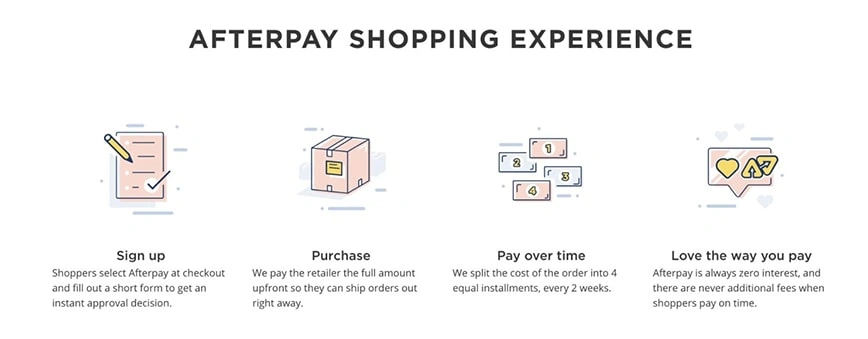
Allowing customers to use Afterpay at checkout lets them pay for their order later in installments. (DELETE THAT TEXT)
The same feature could be used for a wholesale channel or store, allowing you to collect payment information from your retail customers and only charge them later in installments. An app such as Afterpay would allow you to automate the payment collection process, without the need to track and check up manually on unpaid invoices.
Now that you have your wholesale pricing strategy figured out, and a wholesale channel set up in your store, it’s time to search for prospective wholesale customers. But where do you find these retailers?
Ofter, a retail customer will find you first. If you’ve had success with direct-to-consumer advertising, you may have already received messages from distributors who want to carry your product online or in their physical stores.
When you are advertising to consumers online, you are also reaching other business owners who might be interested in carrying your product. This is why it is important to keep a link in your website footer for wholesale inquiries. This provides an easy way for anyone browsing your website to contact you about potential opportunities.
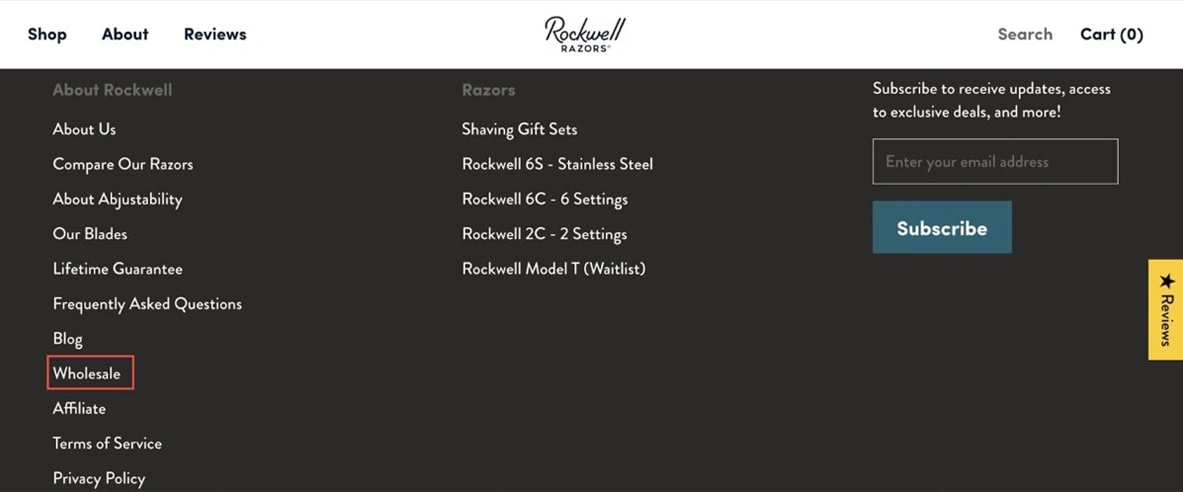
Tradeshows are one of the most traditional places that a wholesale business will go to make connections and find retail partners. There are speciality trade shows for nearly every category of retail, from baby apparel and athletic leisure clothing to furniture and home decor. There are even trade show directories that will list top trade shows according to categories.
Trade shows, however, can be expensive. They often require travelling to the location where the show is taking place, and a substantial fee for a booth if you want to exhibit there. Although trade shows are a place to make great connections and find new customers, it is worth attending them first and walking the floor to make sure it’s worthwhile before deciding to exhibit.
Another way to get your product on other retailers' sites is through online supplier marketplaces like Doba or Modalyst.
Many retailers are looking to drop ship products through their eCommerce stores and need their local suppliers. In these marketplaces, you can list products from your Shopify store (usually for a small fee) and start dropshipping orders to retailers as they generate sales for you.
One added benefit of a wholesale channel is that, unlike direct-to-consumer, you don’t always need a large volume of customers to grow. If you have a handful of high-quality retailers who are successful at selling your product, they can come back and continue to place larger orders again and again.
To find these partners, it's worth reaching out personally over social media, phone, or email to a company that you believe would be a great fit. A business that sells complementary products would be a good place to start.
One example of a wholesale collaboration between two complementary brands can be found with Pehr and Stokke:
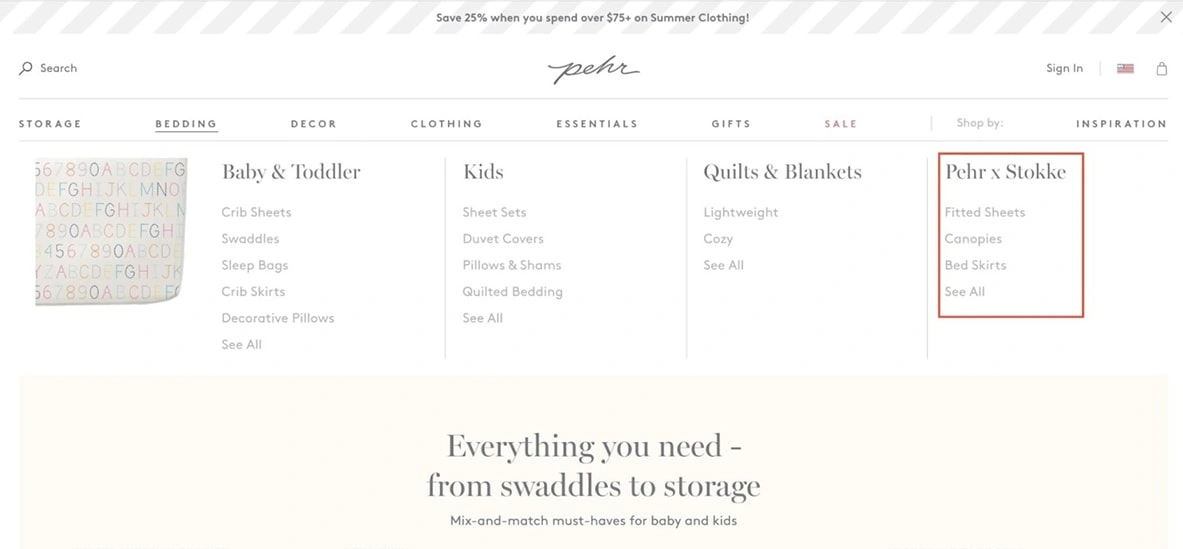
Pehr and Stokke formed a partnership, and now sell each other's complementary products on their respective websites.
Stokke sells a line of cribs and baby furniture for design-minded families. Pehr created a line of 100% organic sheets that are now sold on the Stokke website, while Pehr now carries Stokke's cribs on their website.
Some of the best wholesale partnerships are made through personal contact and establishing trust and rapport in real life. So if you see a brand you admire, it's worth reaching out to them if you believe working together would be beneficial on both sides.
The rise of eCommerce has allowed direct-to-consumer brands to launch faster and grow digitally. As a result, many had written off wholesale as a fading retail trend. However, a new wave of wholesale businesses are thriving in the era of eCommerce by rethinking the way wholesale works.
Both direct-to-consumer brands looking for new sales channels, and entrepreneurs who want to save on marketing spending, are opening up wholesale businesses. With the right pricing strategy and the proper setup, you can start opening your business up to a new revenue -generating partnerships and see your product flourish amongst other complementary brands.
There are several products that you can sell, depending on whom you want to market to and the suppliers you're in contact with. Here are some examples:
Yes, you can use Shopify to sell your products to other businesses. You can either set up a password-protected storefront for your customers, or you can set up volume discounts on specific products that you want to sell on a wholesale basis.
To kick start your business and sell wholesale and retail, hire expert Shopify developers from Dotsquares.
To ensure your wholesale profit margin is at least 50%, a good place to start is to multiply your cost of goods by two to set your wholesale prices.
We hope this article covers all of your queries, but if you still have some questions or want to expand your business into online, then we highly recommend hiring Dotsquares for the best development solutions.
Original Post: https://www.shopify.in/blog/selling-wholesale
Discover AI agent integration for websites, real use cases, costs, and results. Learn how modern AI agents improve customer experience and scalability.
Keep ReadingWe are now official Progress Partner, delivering intelligent Sitefinity CMS solutions, AI-powered personalisation, & enterprise-grade digital experiences globally.
Keep ReadingDiscover how HubSpot’s AI-powered Smart CRM uses automation, Breeze AI, and integrations to create personalised, human customer relationships.
Keep Reading